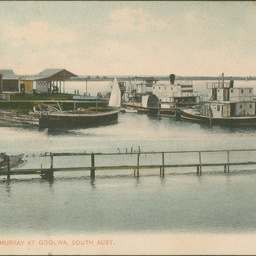Find • goolwa • Results 301 to 330 of 929

![[Plan of townships of Currency Creek and Goolwa] [cartographic material] /
drawn by Philip L. Snell Chauncy. Surveyor, Adelaide](https://slsa-collections.s3.amazonaws.com/09/51/c8c7-142a-5e03-909e-8c2b3d12134f.jpg)
[Plan of townships of Currency Creek and Goolwa] [cartographic material] / drawn by Philip L. Snell Chauncy. Surveyor, Adelaide
Map showing town plans for Currency Creek and Goolwa, South Australia. Details include lot numbers and street names, position of town squares and public cemetery. No relief shown.


PS Waradoery
PS 'Waradoery' tied up at Goolwa.


River boats
River boats Excelsior and an unidentified vessel at Goolwa, Easter 1901. According to a researcher, the vessel on the right is the Jolly Miller.


Barrage, Goolwa
Aerial view of the barrage under construction.


Flour Mill, Goolwa
Early house and flour mill.


Paddle steamer "Cadell "
Paddle steamer Cadell at Goolwa.


Barrage, Goolwa
The Barrage at Goolwa nearing completion.


"Captain Sturt", Steamboat
River steamer Captain Sturt berthed at Goolwa.


"Murray River Queen"
The " Murray River Queen " at the Goolwa wharf.


"Murray River Queen"
The Murray River Queen at the Goolwa wharf.


Uniting Church, Goolwa
Goolwa Uniting Church, which was previously the Wesleyan Chapel, opened on 23/12/1861.


Uniting Church, Goolwa
Goolwa Uniting Church.


First South Australian tramway
A horse-drawn tram on the Goolwa to Port Elliot railway line. Identified as the 'first South Australian tramway', this line was opened in 1854, with horses used to pull the trams until the introduction of steam engines in 1884. The line was extended to Victor Harbor in 1864 and continues to operate as a light rail link known as the Cockle Train.


Edward Peck Fisher
Edward Peck Fisher who ran the general store at Goolwa.


Aborigines, Goolwa
Aborigines outside their dwelling.


Flour mill, Goolwa
The derelict Mill in 1947.


Pupils outside Goolwa School
Schoolchildren and teachers in a group photograph outside Goolwa School.


Goolwa
Stereoscopic view of Main Street, Goolwa. A carriage and horse riders have assembled in front of [probably] the Corio Hotel, with onlookers on the balcony.


Goolwa Hotel
Goolwa Hotel with group of horsedrawn carts assembled out the front.


Goolwa
Main street of Goolwa showing the hotel among other buildings.


Goolwa
Sketch of a landscape scene at Goolwa, with a small fishing boat and two figures in the foreground. The artist, Alexander Charles Kelly (1811-1877) was a newly arrived Scottish medical practitioner and winegrower.


Goolwa wharf
River craft moored at the Goolwa wharf, with a number of adjacent buildings. The 1874 extension to the wharf has been completed, but the 1878 wharf shed is not present.


Queen, Paddle Steamer
Queen, Paddle Steamer - on left in 1868 when propelled by a stern wheel and in 1932 on the right. The back of this photograph contains a newspaper clipping from the Chronicle May 19, 1932 detailing the "Queen's" long service. A portion of this is "Captain Peckhills was master of her, and she ran a three-weekly trip between Goolwa and Wentworth with passengers and cargo. When the Duke of Edinburgh came out in the Galatea, he was taken over the lakes in the "Queen" for a kangaroo hunt and to witness a corroborie at Point McLeay".


Residence, Goolwa
Residence of Mr Thomas Jones, the first Tramway Superintendent of Goolwa Tramways. The building appears to be built close to the edge of a cliff.


Shipping at Goolwa
Shipping at Goolwa.


"Decoy", Goolwa
"Decoy", River steamer built in Melbourne in 1876. Decoy (Paddle steamer). She was brought out from Scotland in sections and built in Melbourne. She was originally designed to burn coal but was modified to burn wood. In her time she worked the St Vincent Gulf, was a barge and passenger vessel. In 1925 "Decoy" towed the barge "Cowie" which carried a record 2493 bales of wool on the Murray.


"Industry", Goolwa
The launching of the "Industry", River steamer. This PS "Industry" was built in 1911. The Centenary Celebrations will be held in 2011 at Renmark. Please note: possible confusion as another "Industry" was was built in 1878 as a barge and converted to a steamer in 1878. She was used for snagging operations for the South Australian Government and also for delivering pile timber in 1926.


"Queen", River steamer
"Queen", River steamer - built at Goolwa in 1865, lengthened in 1872. "Queen" was a stern wheeler of 127 tons and used as a trading steamer that also carried passengers. She collided with "Jane Eliza" in 1876 and sank. She later towed "Bourke", and successively became a floating cold storage and butcher's shop based at Renmark. She finally burned and sank at Mypolonga.


Goolwa Wharf
Goolwa Wharf showing Paddle Steamers "Cumberoona" (left of beacon) and "Wentworth" (right stream) "Ellen" is at the wharf.


Goolwa wharf
Goolwa wharf in approximately 1904. The port was one of Australia's most important river ports, the wharf was built in 1852 and later extended and rebuilt several times. This photograph shows paddle steamers moored at the wharf and Hindmarsh Island in the background
